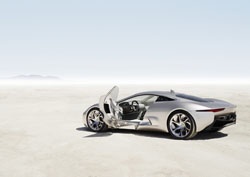There’s a definite buzz around the NEC as we go into the second day of the Engineer Conference 2013 at the Subcon Show. It’s coming from the machine tools on the Mazak stand just outside our conference theatre, we think; they’re demonstrating how to work titanium and aluminium, and it’s unsurprisingly a bit loud. But despite the background noise, the first day of our inaugural conference has already seen some striking presentations, and a few themes are emerging.
Keynote speaker Bob Joyce, engineering director of Jaguar Land Rover demonstrated where the thin line between being a cutting-edge innovator and a reckless risk taker lies. After explaining the dramatic improvements in fuel economy between a 1974 Range Rover and next year’s model, from 30 miles on 10 litres of fuel to 95, thanks to improvements in engine technology and weight reduction; however, he was adamant that ‘I’ve always said that I won’t be the first person to come out with a driverless car: there will inevitably be teething problems, somebody’s going to get sued, and it isn’t going to be me.’

In a panel discussion, Joyce’s colleague Dai Jones, of Jaguar Land Rover’s R&D division, demonstrated the lengths the company will go to in the search for weight reduction. Cutting weight in the roof of a car is very important for handling, he explained, but Jaguar customers like their hand-stitched leather head-liners and they are very heavy. ‘We tried engineered leather, made out of offcuts,’ he said. ‘We even tracked down some very athletic yaks in the Himalayas who can clamber up almost sheer rock faces and have very thin, lightweight skin, although harvesting their hides would have been a problem. But our customers are very concerned with authenticity, so we ended up staying with the traditional leather. Sometimes,’ he said, ‘you just can’t make the improvements you want to.’
Bob Joyce was one of several speakers who commented that although the best graduates coming out of UK engineering degree courses are very talented, there just aren’t enough of them. Patrick Wood, satellite engineering chief at Astrium UK, also said that he had trouble recruiting enough engineers from the UK, especially in areas such as embedded real-time software. ‘We end up recruiting from Italy, France, Spain and Germany to make up the numbers we need,’ he told me, ‘which is great for them because they get to improve their English as well. But we’d rather recruit from the UK.’
The UK’s expertise in composites was also on display, with the designer of one of the most striking examples of its success, the bikes of the all-conquering Team GB Olympic cycling team, explaining how he went about shaving the vital thousands of a second off lap time. Dimitris Katsanis of small manufacturing firm Metron used finite element analysis to fine-tune out stresses in the frames of the bikes, he said, blending different types of fibre and working out the effects even of changing the direction of the weave of the fibres. This, he added, was against the backdrop of constant calls from UK Cycling telling him how much force Chris Hoy was generating in training, which the bottom bracket of his frame would have to withstand. ‘One day I was told he was generating 500Nm of torque,’ he said. ‘The next week it was 600. A week later it was 750Nm.’ That’s equivalent to a sports car engine, he said; balancing the strength of the frame against the lightness that helped obtain quick times was a tricky job. ‘Cutting 200g off the frame weight could lead to a few thousands of a second off a lap time, and that’s about 0.29m of distance,’ he said, ‘and in 2002 Hoy win a World Championship by 0.001sec. Little things count.’
Meanwhile, Airbus UK R&D chief Colin Sirett explained how composites and manufacturing methods could have a huge effect on how the company builds planes. ‘You could say that what we really do is drill holes,’ he said. ‘With the wings we make in the UK, we drill 60million holes per year. If we can reduce that, by making panels with holes already in them for example, it would be amazing. Just by 30 per cent. Is it too much to ask to only drill 40million holes? Mind you,’ he mused, ‘it wouldn’t be good news for all the drill-makers out in the Subcon Show.’





Project to investigate hybrid approach to titanium manufacturing
What is this a hybrid of? Superplastic forming tends to be performed slowly as otherwise the behaviour is the hot creep that typifies hot...